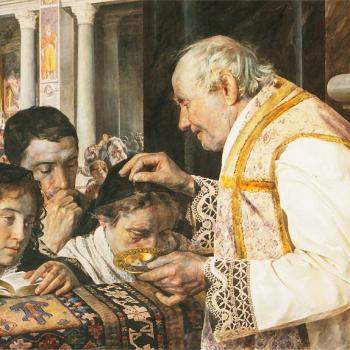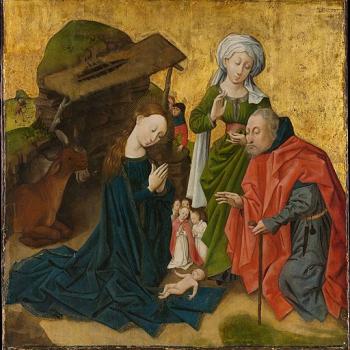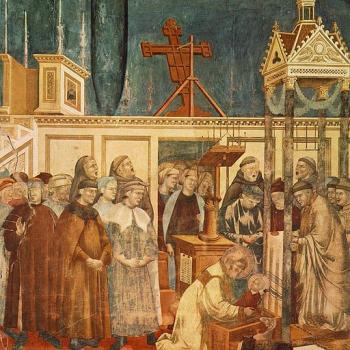I want to return to a post I wrote six years ago, on the question of what to do with the last remaining samples of smallpox. In that post I was wrestling with the distinctions between dominion and stewardship, using smallpox as an extreme example. Under a dominion model of creation, we have an absolute right to destroy smallpox both in the natural environment and the last remaining samples–a question which continues to be debated. Under the stewardship model, I had some reservations which were related to the fact that smallpox was part of God’s creation (if only in a contingent sense) and it was unclear how far our authority over creation extended under this model.
Though he does not consider the specific question of smallpox, Pope Francis does address this question of stewardship versus dominion in detail in his encyclical Laudato Si’. He takes as his starting point the two creation stories in Genesis, each of which presents a different emphasis on the role of humanity in creation. And it is clear, reading the Pope’s analysis (see Chapter 2) that there is a tension between these two accounts, one which he is is endeavoring to understand and balance. This is not easy, and in rereading the text this morning I realized that it would be easy to pick out quotes from this chapter to support either side of the argument about smallpox.
I first became aware of this tensions because, as part of our reading of Laudato Si’ my fraternity has been watching the sixteen part video series about it by Dan Horan, OFM. Father Horan does a remarkably good job of breaking the text down into manageable pieces that facilitate group discussion. But in watching the very first episode, where he discusses models of creation, I noticed that he focused on certain quotations from Chapter 2 that emphasized the stewardship model of creation, while downplaying any idea that humanity has any kind of dominion over creation, however limited. In particular, he ignored the argument the Pope lays out in paragraphs 79-81, where he talks about the unique nature of humanity as personal, self-aware beings who can enter into relationship with their creator, and who have been called to play a role as co-creators with God. Humanity does have dominion over creation, but one which requires us to act in accordance with the ultimate plan of the Father.
The Pope, in his closing paragraph, lays out this ultimate plan in a way which suggests, at least to me, that our dominion might not extend to destroying smallpox. He writes
The ultimate purpose of other creatures is not to be found in us. Rather, all creatures are moving forward with us and through us towards a common point of arrival, which is God, in that transcendent fullness where the risen Christ embraces and illumines all things. Human beings, endowed with intelligence and love, and drawn by the fullness of Christ, are called to lead all creatures back to their Creator.
“All creatures” would seem to include smallpox, and if they are to “mov[e] forward with us” that would seem to preclude removing them from creation all together. However, in rereading the Pope’s argument, I concluded that this would be a more persuasive interpretation were creation static: if indeed, all creatures had been formed by the hand of God during the first week, and nothing was to change. In this case, it would make sense that we were to tend this fixed, finite creation and return it to the Father, perhaps with such additions as we could make out of our own creativity. (Cf. the parable of the talents, Mt 25:14-30.)
But creation is not fixed: it is growing and changing and this growth and change is part of God’s original plan, in order to bring us into our role as co-creators with God:
Creating a world in need of development, God in some way sought to limit himself in such a way that many of the things we think of as evils, dangers or sources of suffering, are in reality part of the pains of childbirth which he uses to draw us into the act of cooperation with the Creator (para. 80).
To use modern biological terms, the universe is evolving, and species are being created and destroyed as part of this process: to wit, the dinosaurs. If humans are to become co-creators with God, then this suggests that in some small way, we can and should interact with this evolving universe. And from the earliest days of prehistory, we have done this. We domesticated plants and animals, and by selective breeding we have altered the course of evolution. Thus dogs and wolves are now different species, and corn, wheat and other staple crops are distinct from their wild progenitors. We have created what did not exist before, and would, had evolution followed a “natural” trajectory, never come into existence.
So then, the question is: if we are allowed to create as part of our role in the self-conscious evolution of the universe, are we also, in any way, allowed to destroy? The power to build includes the power to tear down; the power to plant the power to weed and to pull up. And though a much more momentous step, I believe that this extends to the creation and destruction of species.
My justification for this comes in paragraph 79, which I want to quote in full (emphasis added):
In this universe, shaped by open and intercommunicating systems, we can discern countless forms of relationship and participation. This leads us to think of the whole as open to God’s transcendence, within which it develops. Faith allows us to interpret the meaning and the mysterious beauty of what is unfolding. We are free to apply our intelligence towards things evolving positively, or towards adding new ills, new causes of suffering and real setbacks. This is what makes for the excitement and drama of human history, in which freedom, growth, salvation and love can blossom, or lead towards decadence and mutual destruction. The work of the Church seeks not only to remind everyone of the duty to care for nature, but at the same time “she must above all protect mankind from self-destruction”.
Smallpox is a product of evolution, but does not represent a positive direction. Indeed it is a source of great suffering and death (killing tens of millions–indeed, it is one of the diseases responsible for the catastrophic collapse of New World populations after the arrival of Europeans in 1492). So then, I would now argue, that humanity can intervene to undo the natural evil that evolution has produced. Smallpox can be eradicated in nature, and in fact, for the safety of humanity, it should be extirpated. Given the potential dangers samples of the disease represent, it must be destroyed to “protect mankind from self-destruction.”
I am satisfied now with my understanding, at least as it relates to smallpox, but I remain troubled as I try to determine the consequences of this argument. Polio, of course, now falls into the same category as smallpox, and I am happy with the fact that may be eliminated in nature in a decade. (The obstacles now are primarily political, with various groups resisting immunization campaigns. This opposition has included, unfortunately, Catholic bishops in Kenya.) But where do we draw the line? When does the destruction of species cross over from being co-creators with God of a better world, and when does it cross the line into “view[ing] other living beings as mere objects subjected to arbitrary human domination”? (para. 82) Where does dominion cease to be responsible stewardship and become the sinful expression of pride and self-will?
One might go to the other extreme and posit as categorically wrong the destruction of species and ecosystems for material profit (such as the widespread destruction of the Amazon for mining, logging and commercial agriculture). But, in doing so we have to be cognizant that humanity has already done this: the introduction and spread of agriculture, even before the industrial revolution, has changed ecosystems around the world. Here in America, the westward expansion of the 19th century resulted in the large scale deforestation of large regions (with the concomitant destruction of large and varied ecosystems including the extinction of many species) and their conversion to agricultural mono-crops. How do we distinguish between the two? And if we decide they are the same, how do we make reparations for the harms already committed?












